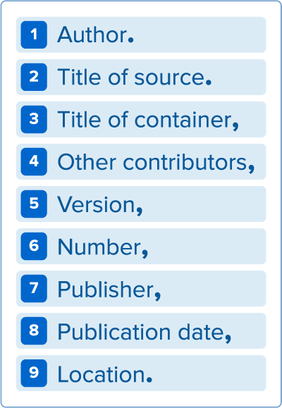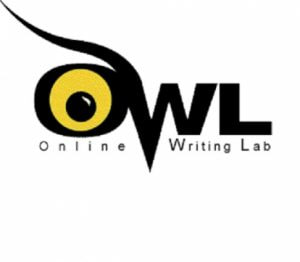CITATIONS
|
MLA (Modern Language Association) style is most commonly used to write papers and cite sources within the liberal arts and humanities.
The new MLA (8th ed.) format is now the same for ALL sources, regardless of source type.
Author. Title of Source. Title of Container, Other contributors, Version, Number, Publisher, Publication Date, Location. |
Author
Begin the entry with the author’s last name, followed by a comma and the rest of the name, as presented in the work. End this element with a period.
Title of source
The title of the source should follow the author’s name. Depending upon the type of source, it should be listed in italics or quotation marks.
Italics: Books, Websites
Quotation marks: Periodical (journal, magazine, newspaper), song or piece of music
Title of container
Unlike earlier versions, the eighth edition refers to "containers." The container is the larger whole in which the source is located. For example, if you want to cite a poem that is listed in a collection of poems, the individual poem is the source, while the larger collection is the container. The title of the container is usually italicized and followed by a comma, since the information that follows next describes the container.
Examples:
- a television series, which is made up of episodes.
- a website, which contains articles, postings, and other works
- keep in mind, a container might be within a larger container!
(such as an article found in a scholarly journal that you found in a database)
Other contributors
In addition to the author, there may be other contributors to the source who should be credited, such as editors, illustrators, translators, etc. If their contributions are relevant to your research, or necessary to identify the source, include their names in your documentation. Note: In the eighth edition, terms like editor, illustrator, translator, etc., are no longer abbreviated.
Version
If a source is listed as an edition or version of a work, include it in your citation.
Number
If a source is part of a numbered sequence, such as a multi-volume book, or journal with both volume and issue numbers, those numbers must be listed in your citation.
Publisher
The publisher produces or distributes the source to the public. If there is more than one publisher, and they are all are relevant to your research, list them in your citation, separated by a forward slash (/). Note: the publisher’s name does not need to be included in the following sources: periodicals, works published by their author or editor, websites whose titles are the same name as their publisher, websites that make works available but do not actually publish them (such as YouTube, WordPress, or JSTOR).
Publication date
The same source may have been published on more than one date, such as an online version of an original source. For example, a television series might have aired on a broadcast network on one date, but released on Netflix on a different date. When the source has more than one date, it is sufficient to use the date that is most relevant to your use of it. If you’re unsure about which date to use, go with the date of the source’s original publication.
Location
You should be as specific as possible in identifying a work’s location.
- An essay in a book, or an article in journal should include page numbers.
- The location of an online work should include a URL. Remove any "http://" or "https://" tag from the beginning of the
URL.
- A physical object that you experienced firsthand should identify the place of location.
Begin the entry with the author’s last name, followed by a comma and the rest of the name, as presented in the work. End this element with a period.
Title of source
The title of the source should follow the author’s name. Depending upon the type of source, it should be listed in italics or quotation marks.
Italics: Books, Websites
Quotation marks: Periodical (journal, magazine, newspaper), song or piece of music
Title of container
Unlike earlier versions, the eighth edition refers to "containers." The container is the larger whole in which the source is located. For example, if you want to cite a poem that is listed in a collection of poems, the individual poem is the source, while the larger collection is the container. The title of the container is usually italicized and followed by a comma, since the information that follows next describes the container.
Examples:
- a television series, which is made up of episodes.
- a website, which contains articles, postings, and other works
- keep in mind, a container might be within a larger container!
(such as an article found in a scholarly journal that you found in a database)
Other contributors
In addition to the author, there may be other contributors to the source who should be credited, such as editors, illustrators, translators, etc. If their contributions are relevant to your research, or necessary to identify the source, include their names in your documentation. Note: In the eighth edition, terms like editor, illustrator, translator, etc., are no longer abbreviated.
Version
If a source is listed as an edition or version of a work, include it in your citation.
Number
If a source is part of a numbered sequence, such as a multi-volume book, or journal with both volume and issue numbers, those numbers must be listed in your citation.
Publisher
The publisher produces or distributes the source to the public. If there is more than one publisher, and they are all are relevant to your research, list them in your citation, separated by a forward slash (/). Note: the publisher’s name does not need to be included in the following sources: periodicals, works published by their author or editor, websites whose titles are the same name as their publisher, websites that make works available but do not actually publish them (such as YouTube, WordPress, or JSTOR).
Publication date
The same source may have been published on more than one date, such as an online version of an original source. For example, a television series might have aired on a broadcast network on one date, but released on Netflix on a different date. When the source has more than one date, it is sufficient to use the date that is most relevant to your use of it. If you’re unsure about which date to use, go with the date of the source’s original publication.
Location
You should be as specific as possible in identifying a work’s location.
- An essay in a book, or an article in journal should include page numbers.
- The location of an online work should include a URL. Remove any "http://" or "https://" tag from the beginning of the
URL.
- A physical object that you experienced firsthand should identify the place of location.
The Purdue OWL
NOODLETOOLS
|
Use NoodleTools to cite and evaluate sources, create works cited pages, and even generate parenthetical citations!
you are ultimately responsible for confirming that your citations are correct! |




